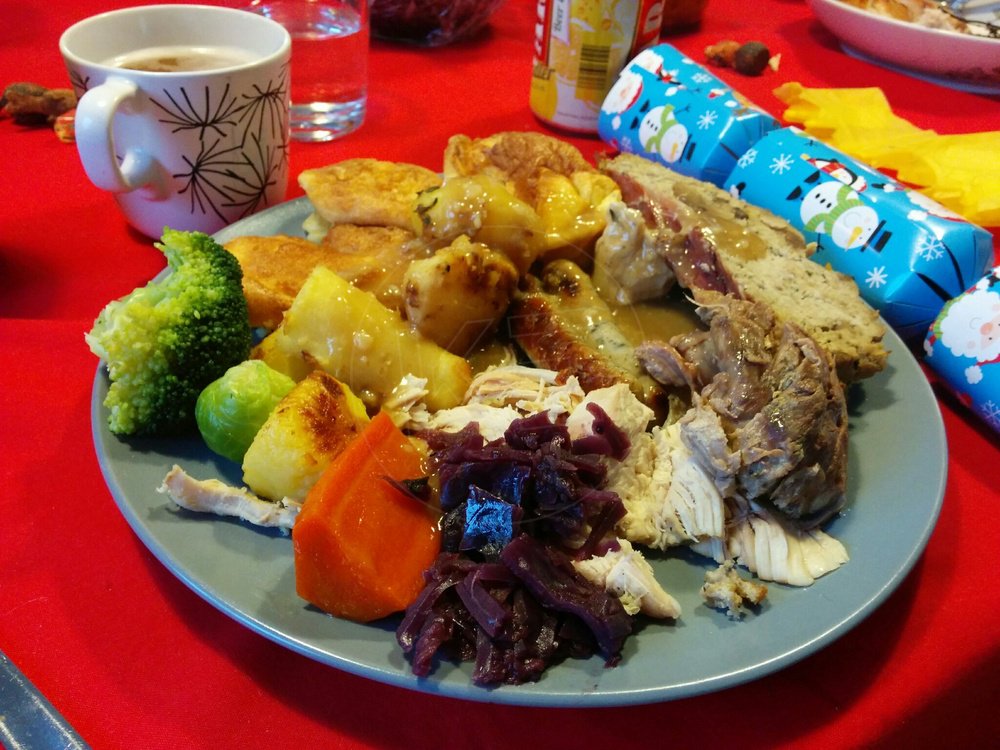Let’s get this out of the way at the beginning. I don’t like ‘kapustnica’ (’sour cabbage/sauerkraut soup’). I’m sorry. I know you love it, and I wish you many happy gallons of it.
But after 19 years in Slovakia, I still find it utterly repulsive. I promise you, there are plenty of Slovak foods I love, but I don’t think I’ll ever be able to regard sour, body-temperature liquid (with bits) as appetising. But life would be boring if everyone ate the same food and did the same things, right? As an Englishman living in Košice, I’m lucky enough to get the best (and worst) of both worlds at Christmas. Read on if you’d like to find out what’s the same and what’s different, while simultaneously practising your Christmas vocabulary :)
There are many commonalities, of course. Christmas is a religious festival in both countries (though this is not its primary significance for many British people). Christmas is, for many people, a time for families to come together. For most, it probably means time off work and, for many, an excuse to drink heavily and eat more than is good for them. And we share most of the same symbols and decorations: fairy lights on Christmas trees, wreaths, baubles, mistletoe, and the gaudy Christmas lights that people increasingly like to wrap their houses with. Look at this: a wreath, baubles and fairy lights (and other decorations), mistletoe
The UK and Slovakia also share a love of baked goods flavoured with ginger, cloves, nutmeg and/or cinnamon, and sweetened with honey, sugar or treacle/molasses. In the UK, the hard, biscuity form is called gingerbread, and the softer incarnation is ginger cake (perhaps ‘parkin’), with the (originally German) lebkuchen somewhere in between. I ask my students every year what they call these things in Slovak, and there is never complete agreement - feel free to discuss the difference between ‘perníky’ and ‘medovníky’ in the comments. Look: gingerbread, ginger cake, lebkuchen
Those same spices (without the ginger, perhaps) are also found in mulled wine in both countries, and are used to flavour practically all the sweet things on a British Christmas table. Christmas pudding is, in fact, a kind of steamed fruit cake (one of many meanings of the word ‘pudding’), while Christmas cake is a not-wholly-dissimilar fruit cake, which is baked and traditionally covered first with marzipan and then with icing. Finally, mince pies are pastry cases filled with a sweet mixture of dried fruits and peel (they originally also contained minced meat, but no longer). All contain the ubiquitous Christmas spices.
Pictures: Christmas pudding, Christmas cake, mince pies.
Our savoury dishes have little in common. While I’m sure traditions vary from family to family, I think it’s fair to say that soup is not an essential part of the British Christmas meal, and neither are 'poppy seed balls’ (bobáľky) or wafers with honey and garlic. For their main course, Slovaks tend to have potato salad and fish - traditional carp, fashionable salmon, or unfathomable pangasius - seriously, is that really a fish? Meanwhile, the British have a bird (most often turkey), accompanied by some combination of chestnut stuffing, sausages, roast potatoes and parsnips, yorkshire puddings, brussel sprouts, cranberry sauce and gravy. Mmmmmmmmmm…
The timing is also rather different. British Christmas Day is on 25th December. During Slovak Christmas on 24th, we have Christmas Eve, dedicated to last-minute shopping, pre-Christmas drinks, and excited children. When the (relevant) big day arrives, Slovaks are supposed to fast till the evening, on the promise that if they do so successfully, they will see a golden pig (most likely in the grip of a hypoglycaemic hallucination). Only after eating do they open their presents. The British show no such restraint. In our family, at least, we open presents after breakfast, then graze gently like two-legged cows till lunch is ready at about 2pm, then stuff ourselves fit to burst, and then resume our grazing.
Let's not forget that Christmas isn't just about food: TV also plays a pretty significant part in both cultures' traditions. Home Alone and animated films like Happy Feet have become Christmas staples in both countries. But whereas Slovak schedules are otherwise filled mostly with fairytales - Mrázik (my favourite), Three Hazelnuts for Cinderella, Perinbaba - British TV tends to favour James Bond and (modern) classics like Mary Poppins and Back to the Future. Some of these may even have an actual link to Christmas, like Die Hard or Elf (great films!). We also have the Queen’s Speech at 3pm and some especially dramatic and depressing episodes of the nation’s favourite soap operas.
Q What does Karel Gott say when he can’t find his underpants?
A 'Kdepak ty ptáčku hnízdo máš?’
What of other traditions? Well, both British and Slovak people are familiar with midnight Mass, Christmas cards and carols (though Slovaks don't go carolling from door to door). But I’ve never seen a Slovak Santa's grotto (a room in a department store where children go to sit on Santa’s knee and tell him what they want for Christmas). Nor a panto, thankfully (a kind of play for children, based on a fairytale and involving music and jokes).
Likewise, although it is common to see nativity scenes in both countries, Slovakia has yet to embrace primary school nativity plays, in which children dress up as angels, donkeys, Joseph and Mary to act out the story of Jesus’s birth. The Slovak version seems to be the 'Vianocna akademia’, in which each class does a song and/or dance routine, to the endless delight of their parents.
Both countries have a pretty healthy selection of dinner table traditions. Slovak families might put fish scales under the tablecloth (for wealth), and cut an apple in half, hoping the seeds form a star (for health). In Britain, some people put a silver coin in the Christmas pudding (the finder will be lucky, assuming they don’t swallow it), while others pull the wishbone of the turkey (the one who gets the bigger bit can make a wish).
And then, there are crackers! These look like over-sized ‘salonky’ (we don’t have those - maybe ‘chocolate Christmas tree decorations’), but contain, instead of chocolate, three gifts - a paper crown, a bad joke and a rubbish toy - and a small explosive. Like wishbones, they are pulled between two people, and the person who is left with the larger part ‘wins' the contents. A video might help:
OK, if you’re Slovak, let’s just do a quick experiment. Think back to when you didn’t know it was your parents who put the presents under the tree while you were out of the room after dinner. Who did it? And what did this person look like? Was it a baby? A man? Did he have a goatee? A big white beard? Was he fat? Or thin? Did he have a red and white costume? How did he get in? Did he have a bag for the presents? Over the last 19 years, I have asked these questions of many students, and received a surprising variety of answers. Of course, for most, the presents are brought by ‘Ježiško’, a diminutive form of the name Ježiš (Jesus). But while many people actually pictured him as a little baby (or, occasionally, an adult Jesus in sandles), more and more children are picturing a fat man in red, with a big white beard.
Presumably, young Slovaks are experiencing cultural interference from the Anglo-American gift-bringer himself: Father Christmas/Santa Claus. These were once two distinct ‘people’ (Father Christmas being more traditional in the UK), but have long since fused into one concept with two names. Between Christmas Eve and Christmas morning, he comes on a sleigh, pulled by a team of reindeer, headed by Rudolf. He traditionally comes down the chimney and leaves presents (for good children) under the tree, or perhaps in stockings hung by the fire or at the end of their beds. The presents might include nuts, tangerines and chocolate for good children and coal for bad ones.
If some of that sounded a little familiar, it certainly should. Father Christmas/Santa Claus is not only the functional equivalent of Ježiško for British children, but his modus operandi is a lot like that of Mikuláš, who leaves gifts in the shoes and boots of good Slovak children during the night of 5th December (not celebrated in the UK since the Reformation). And this similarity is no coincidence, for ‘Svätý Mikuláš’ is 'St Nicholas' in English, and ‘Sinterklaas' in Dutch. And it was this figure that merged with the original English Father Christmas to produce the American Santa Claus. Santa Claus has, in turn, influenced British traditions to such an extent that he and Father Christmas have become one in the same. So, in some sense at least, Father Christmas = Mikuláš + Ježiško. Mikuliško, if you will. Or Ježuláš.
And there we must end our exploration of Christmas. I think I managed to cover all the important stuff except eggnog/vaječný likér (mayonnaise mixed with industrial alcohol) and robins (the quintessential Christmas bird). The best part of Christmas for me? Crackers, Home Alone and presents. And stuffing. And maybe Mrazik. If you have any questions, please ask in the comments, in English or in Slovak.
And have a very Merry Christmas, ya filthy animals!
James
I'm James Blore and I am the Director of Studies at The School of Blore jazyková škola, Košice. I live in a small village with my wife, Dagmar, and daughter, Izabela. I am currently the Central European Dice Masters Champion, and I am also interested in growing, cooking and eating food, building an army of toads, and playing the drums. Find out more www.blore.sk or facebook.com/blore.sk. If you have any questions, just let me know in the comments - English or Slovak is fine :)




